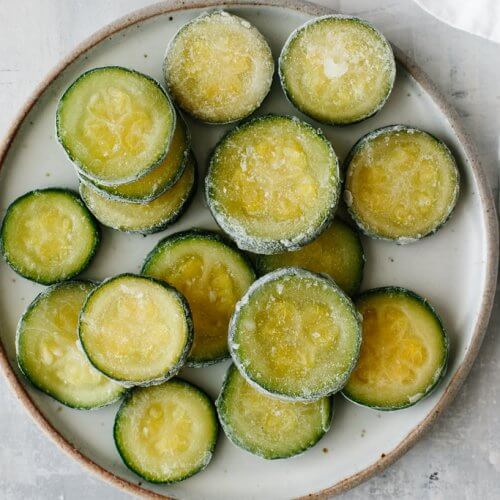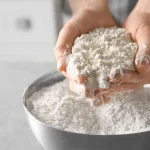Zucchini is always present in our kitchen, thanks to its versatility and its many ways of preparing it. This vegetable is used both to thicken a soup and to present it as a main dish, as is the case with stuffed corvettes and corvette cream.
For this reason, you have probably wondered if zucchini can be frozen to use another day. we tell you everything about it so you can discover how to preserve and freeze zucchini correctly, either raw or in recipes. Go for it!
How to preserve zucchini?
There are several efficient ways to preserve zucchini. You can do it in preserves, through vinaigrettes and pickles, or freeze them. However, if you plan to prepare the zucchini too soon, you can simply refrigerate it. To make it last as long as possible in the fridge, follow these steps carefully:
- Leave it whole. If you cut the zucchini it goes bad faster.
- Don’t wash it. Avoid washing the zucchini, as excess water rots it more quickly.
- Dry it very well until all traces of moisture are removed. Carefully dry the zucchini do it gently. Excess moisture accelerates the appearance of mold.
- Put it in a plastic or paper bag. If you have a zucchini in a bag, its decomposition process will be slower. Since you need air to circulate in the bag, make a few holes before sealing it. If not, you can leave it open.
- Arrange the bags with corvettes inside the refrigerator drawer. Place the zucchini in this area to combat moisture. Of course, the area must be completely clean.
- Do not store zucchini next to fruits that produce ethylene. If you store zucchini near bananas, melons, peaches and others, it will take on a bitter taste.
- Do not store zucchini for more than 5-7 days. Sooner or later, the zucchini will start to wilt, so don’t wait that long to put them to use. The fresher the better.
If you have other questions about preserving vegetables and other foods, don’t miss our article How to preserve and freeze broccoli and Can you freeze cheese?
How to freeze zucchini without blanching?
While blanching is the best way to freeze zucchini or just about any vegetable, you can also freeze zucchini without any prior processing (i.e. raw) with decent results. However, you should keep in mind that as soon as the vegetable is thawed, the deterioration process will accelerate rapidly, something that would happen more slowly if you cooked it beforehand.
If you decide to freeze raw zucchini, you should prepare the zucchini right away and consume it, preferably. To achieve this, just follow these steps:
- Wash the corvettes very well and then dry them carefully.
- Chop the corvettes.
- Store them in a plastic bag that is special for freezing. Place them with some space between them so they don’t stick together when frozen.
- The right temperature to keep them in good condition is -18º C, inside the home freezer. Thus, the zucchini will keep perfect for up to 2 months.
- Once you thaw the zucchini, you should cook them as soon as possible, as the enzymes of the decomposition process will be activated immediately. They will lose color, flavor, and nutritional properties, so you shouldn’t freeze it again either.
Can cooked zucchini be cooked?
Yes you can, but this will depend on the number of times you cook the zucchini. For example, most vegetable products that have been commercially frozen undergo a pre-blanching process. In other words, almost all of them are previously cooked, and then cooked again in our favorite recipes. As blanching is a process that lasts a few minutes, it subtracts very few nutrients from the vegetable and, consequently, it is very effective.
In the case of corvette cream, since we are simply heating frozen food, the loss of organoleptic qualities will be acceptable. On the other hand, if we cook the corvettes, freeze them, defrost them, cook them again and then try to freeze them again, we will not obtain any nutritional benefit from the corvette and, in addition, it will have lost all its organoleptic characteristics (smell, taste, color, texture, etc.).
How to freeze cream of zucchini?
In times when we are all in a hurry, we try to find quick and efficient ways to get things done. For this reason, cooking a dish and freezing it seems like an interesting idea, since it saves us a few hours a day of culinary work. In this case, vegetable creams or purees are emerging as perfect proposals to save time and provide us with a healthy and tasty meal.
However, since vegetable soup usually contains several mashed ingredients, you should consider how each one reacts separately when frozen. That said, all you have to do is follow these steps to freeze creamed zucchini:
- Choose a good recipe. The correct recipe can determine the success or failure of the freezing process. It is important to consider that ingredients such as milk and potatoes are not very compatible with freezing.
- Select good quality ingredients. It is very important to choose fresh and quality products. In this way, the organoleptic qualities of the ingredients will be in their most optimal state.
- Meet the cooking times. Be careful not to exceed the cooking time, as it subtracts nutrients from the preparation and sensory qualities.
- Don’t go overboard with the salt. During the freezing process, the salt becomes highly concentrated.
- Blend the zucchini cream very well. The texture should be homogeneous and as fine as possible.
- Let the cream cool completely. Before packaging the preparation, it must be cold.
- Store the cream in airtight plastic containers. Containers or bags they must be designed to freeze.
- Distribute the preparation in portions of 250 ml per person or the amount that you consider most appropriate for you. Thus, it is much easier to manage the food and you avoid defrosting what you will not consume at the moment.
- Avoid filling containers to the brim. Remember that when frozen, the content can expand.
- Hermetically close the containers. It is very important to make sure of this, if you don’t, the cream will lose its sensory characteristics and nutrients.
- Identify the content and place the packaging date. It is very important to identify the containers both with name and date, so you can have control of the real expiration time of your food and have an inventory.
- Avoid opening the freezer for the next several hours. This way you avoid changes in temperature while it is being frozen.
How to freeze fresh zucchini?
The most popular way to freeze zucchini is by blanching it first, as is done with most vegetables. This method consists of heating the product to a temperature ranging between 70 ºC and 100 ºC for 30 seconds or more.
This procedure is done with the purpose of inactivating or eliminating enzymes that cause the aging of the vegetable, thus stopping the deterioration of its organoleptic qualities and the partial or total loss of its nutritional contributions. If you want to know how to freeze fresh zucchini and keep all its nutrients, these are the steps you must follow:
- Choose corvettes at their point. When buying corvettes, you must follow certain quality criteria: that they are firm to the touch, compact, small or medium, without spots on the skin and heavy in relation to their size. In this case, the intensity of the color does not serve as a reference, since the color is related to the variety and not to the maturation of the corvette.
- Wash them thoroughly, using cold water. Preferably, rub them with your hands or a special brush for this task.
- Dry the corvettes carefully. Do it gently so you don’t bruise them.
- Cut the zucchini clean and dry. Do as you like, but cut off the ends and decide whether to slice, dice, stick, or grate. The blanching time and how you package them depends on how you cut the zucchini. Think about the culinary uses you will give the vegetable before choosing how to cut it.
- Blanching in cubes or slices: Pour water into a saucepan until it fills 2/3 of its space. Turn on the burner to high heat. When the water boils, place the slices or cubes of zucchini without covering the pan. Wait 3-4 minutes and remove it.
- Grated blanching: in this case, the procedure is steamed. To cook the grated zucchini, use a steamer over a saucepan filled with boiling water. Place the zucchini in the steamer, cover it and wait 2-3 minutes.
- Do not add salt to the scalding water. If you do, the zucchini will go bad more quickly.
- Prepare a pot or bowl with cold water. As soon as you remove the zucchini from the blanching, submerge it in cold water to slow down the cooking. If you steamed it, use the inverted water bath method instead. Wait a couple of minutes.
- Dry the zucchini very well. Use kitchen paper and dry them carefully.
- Save the grated zucchini. You can put it inside a freezer bag, always taking care that there is no air left inside when closing it. Use special plastic bags for freezing.
- Store the zucchini in slices or cubes. Place the zucchini pieces apart from each other. Wait a few hours for the pieces to freeze. After the time, you can transfer the pieces to another special freezer bag or airtight container to freeze them again, separated from each other.
How to defrost zucchini?
You’ve already frozen the zucchini and it was a success, but now you need to defrost it. Have it ready to go in your favorite recipes with these 3 easy methods to defrost zucchini:
- Refrigerated: Transfer the container from the freezer to the refrigerator. Leave the container there until it thaws or, better yet, until the zucchini thaw a little (enough to move them). At this time, move them to another container that has a grid or improvise one. This way, the melted water will be separated from the corvettes. This process can take up to 24 hours.
- Cooked: This defrosting method is the most recommended for vegetables and other foods. You will only have to cook it in boiling salted water.
- Using cold water: if you want to defrost a food using this method, you must check if the container or package is hermetically sealed. This measure is taken to avoid direct contact between water and food during the defrosting process. Submerge the zucchini in cold water, change the water every 10 or 20 minutes, this will speed up defrosting.



